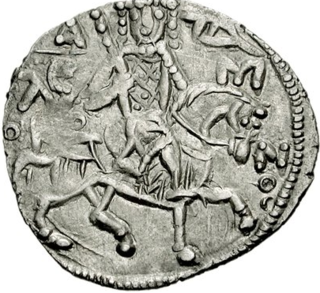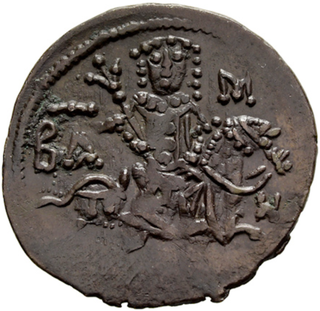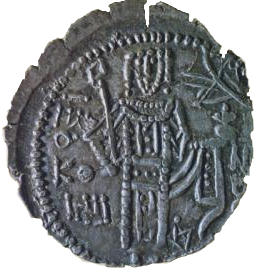Related Research Articles

The Empire of Trebizond, or Trapezuntine Empire, was a successor state of the Byzantine Empire that existed during the 13th through to the 15th century. The empire consisted of the Pontus, or far northeastern corner of Anatolia, and portions of southern Crimea.

Manuel I Megas Komnenos was Emperor of Trebizond from 1238 until his death. He was the son of Emperor Alexios I and his wife, Theodora. At the time Manuel reigned, the Empire of Trebizond comprised a band of territory stretching along the southern coast of the Black Sea. Although Michael Panaretos, a 14th-century Trapezuntine chronicler, calls Manuel "the greatest general and the most fortunate" and states he ruled "virtuously in the eyes of God", the only event he documents for Manuel's reign is a catastrophic fire striking the city of Trebizond in January 1253. The major events of his reign are known from external sources, most important of which is the recovery of Sinope in 1254, which had been lost to the Sultanate of Rum forty years before.
Michael Panaretos was an official of the Trapezuntine empire and a Greek historian. His sole surviving work is a chronicle of the Trapezuntine empire of Alexios I Komnenos and his successors. This chronicle not only provides a chronological framework for this medieval empire, it also contains much valuable material on the early history of the Ottoman Turks from a Byzantine perspective, however it was almost unknown until Jakob Philipp Fallmerayer discovered it in the nineteenth century among the manuscripts of the Biblioteca Marciana of Venice. "Owing to this drab but truthful chronicle," writes the Russian Byzantist Alexander Alexandrovich Vasiliev, "it has become possible to a certain extent to restore the chronological sequence of the most important events in the history of Trebizond. This Chronicle covers the period from 1204 to 1426 and gives several names of emperors formerly unknown."

John II Megas Komnenos was Emperor of Trebizond from June 1280 to his death in 1297. He was the youngest son of Emperor Manuel I and his third wife, Irene Syrikaina, a Trapezuntine noblewoman. John succeeded to the throne after his full-brother George was betrayed by his archons on the mountain of Taurezion. It was during his reign that the style of the rulers of Trebizond changed; until then, they claimed the traditional title of the Byzantine emperors, "Emperor and Autocrat of the Romans", but from John II on they changed it to "Emperor and Autocrat of all the East, the Iberians, and the Transmarine Provinces", although Iberia had been lost in the reign of Andronikos I Gidos.
Alexios IV Megas Komnenos or Alexius IV, Emperor of Trebizond from 5 March 1417 to 26 April 1429. He was the son of Emperor Manuel III and Gulkhan-Eudokia of Georgia.

Alexios II Megas Komnenos, was Emperor of Trebizond from 1297 to 1330. He was the elder son of John II and Eudokia Palaiologina.

Alexios III Megas Komnenos, or Alexius III, was Emperor of Trebizond from December 1349 until his death. He is perhaps the best-documented ruler of that country, and his reign is distinguished by a number of religious grants and literary creations.
Eudokia Palaiologina or was the third daughter of Byzantine Emperor Michael VIII Palaiologos and his wife, Theodora, a grandniece of Emperor John III Doukas Vatatzes of Nicaea.

Basil Megas Komnenos was Emperor of Trebizond from August 1332 until his death in 1340. Although Basil's reign was a period of stability during the civil war that dominated the pocket empire during the second quarter of the 14th century, some of that conflict had its origins in his marital actions.

Michael Megas Komnenos was Emperor of Trebizond from 3 May 1344 to 13 December 1349. He was a younger son of Emperor John II of Trebizond and Eudokia Palaiologina.
Irene of Trebizond was an Empress consort of Trebizond as the bigamous wife of Basil of Trebizond. She had an important position in the regency of her son Alexios III of Trebizond in 1341-1352.
Kaykaus I or Izz ud-DinKaykaus ibn Kaykhusraw was the Sultan of Rum from 1211 until his death in 1220. He was the eldest son of Kaykhusraw I.

Theodora Komnene Kantakouzene was Empress of the Empire of Trebizond as the consort of Emperor Alexios III Megas Komnenos from their marriage in 1351 until her retirement after her husband's death in 1390.
Anna Philanthropene was the second Empress consort of Manuel III of Trebizond.
Bagrationi was the first Empress consort of John IV of Trebizond. Her name is unknown.
Anna Megale Komnene was a Trapezuntine Queen consort of Georgia as the second wife of King Bagrat V. She was the mother of his youngest son, Constantine I of Georgia, who would in 1407 succeed his half-brother, King George VII, and reign as king.
John Lazaropoulos was the Metropolitan of Trebizond from 1364 to November 1367 and a religious writer.
Limnia was the westernmost subdivision of the medieval Empire of Trebizond, consisting of the southern coastline of the Black Sea around the mouth of the Yeşilırmak River.
Theodora Megale Komnene, also known as Despina Khatun, was the daughter of John IV of Trebizond and Bagrationi who married the Aq Qoyunlu ruler Uzun Hasan in 1458. She became the mother of Halima Alamshah Hatun who became the mother of first Safavid king, Shah Ismail I.
Ghiyath al-Din Ahi Ayna Beg was Emir of Erzincan from 1348 until his death. Thought to be a local ahi, he gained control of the region and the city of Erzincan through a purchase from his predecessor sometime before 1348. He was initially loyal to Eretna, after whose death he practiced some degree of autonomy within the Eretnid Sultanate. He waged multiple wars against the Empire of Trebizond and Kingdom of Georgia. He is recorded to have died a shaheed (martyr) and was succeeded by Pir Husayn.
References
- ↑ Panaretos, Chronicle, 49; English translation in Bryer (1975), p.147
- 1 2 Elizabeth A. Zachariadou, "Trebizond and the Turks (1352-1402)", Archeion Pontou, 35 (1979), p. 345
- ↑ Panaretos, Chronicle, 31; English translation in Bryer (1975), p.145
- ↑ William Miller, Trebizond: The last Greek Empire of the Byzantine Era: 1204-1461, 1926 (Chicago: Argonaut, 1969), p. 60
- ↑ Bryer (1975), pp. 135-138
- ↑ Zachariadou, "Trebizond and the Turks", pp. 346ff
- ↑ Bryer (1975), p. 128
- ↑ Sphrantzes, Chronicle, 31.6; translated in Marios Philippides, The Fall of the Byzantine Empire: a Chronicle by George Sphrantzes, 1401-1477 (Amherst: University of Massachusetts, 1980), p. 61
- ↑ Bryer (1975), Appendix II
- ↑ Panaretos, Chronicle, 52; English translation in Bryer (1975), p. 148
- ↑ Miller, Trebizond, pp. 68ff
- ↑ Donald M. Nicol, The Byzantine family of Kantakouzenos (Cantacuzenus) ca. 1100-1460: a genealogical and prosopographical study (Washington, D.C.: Dumbarton Oaks Center for Byzantine Studies, 1969), p. 137 n. 7
- 1 2 Bryer (1975), p. 148, fn. 141
- ↑ Panaretos, Chronicle, 55; English translation in Bryer (1975), p. 148